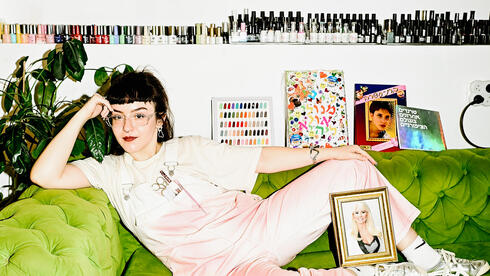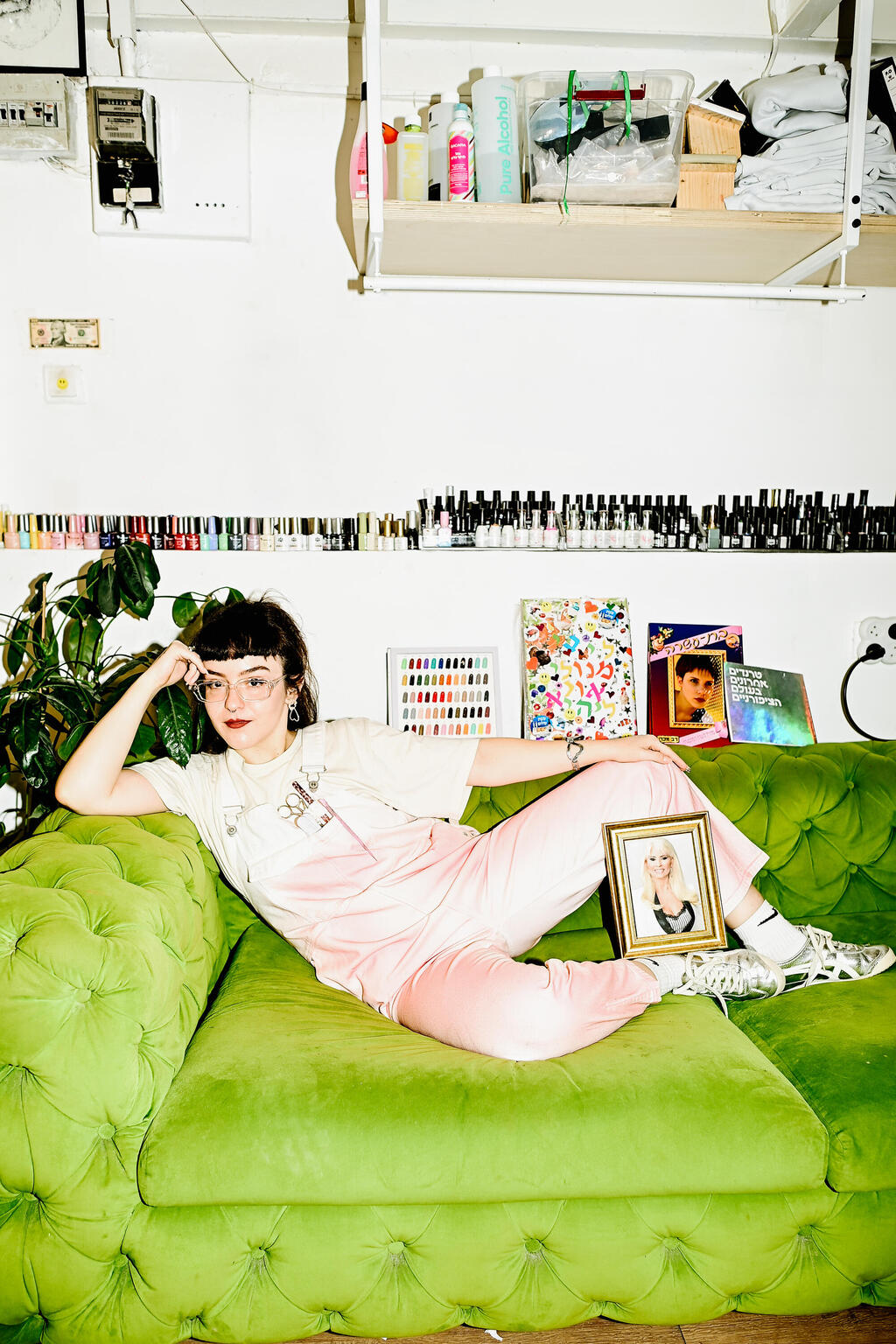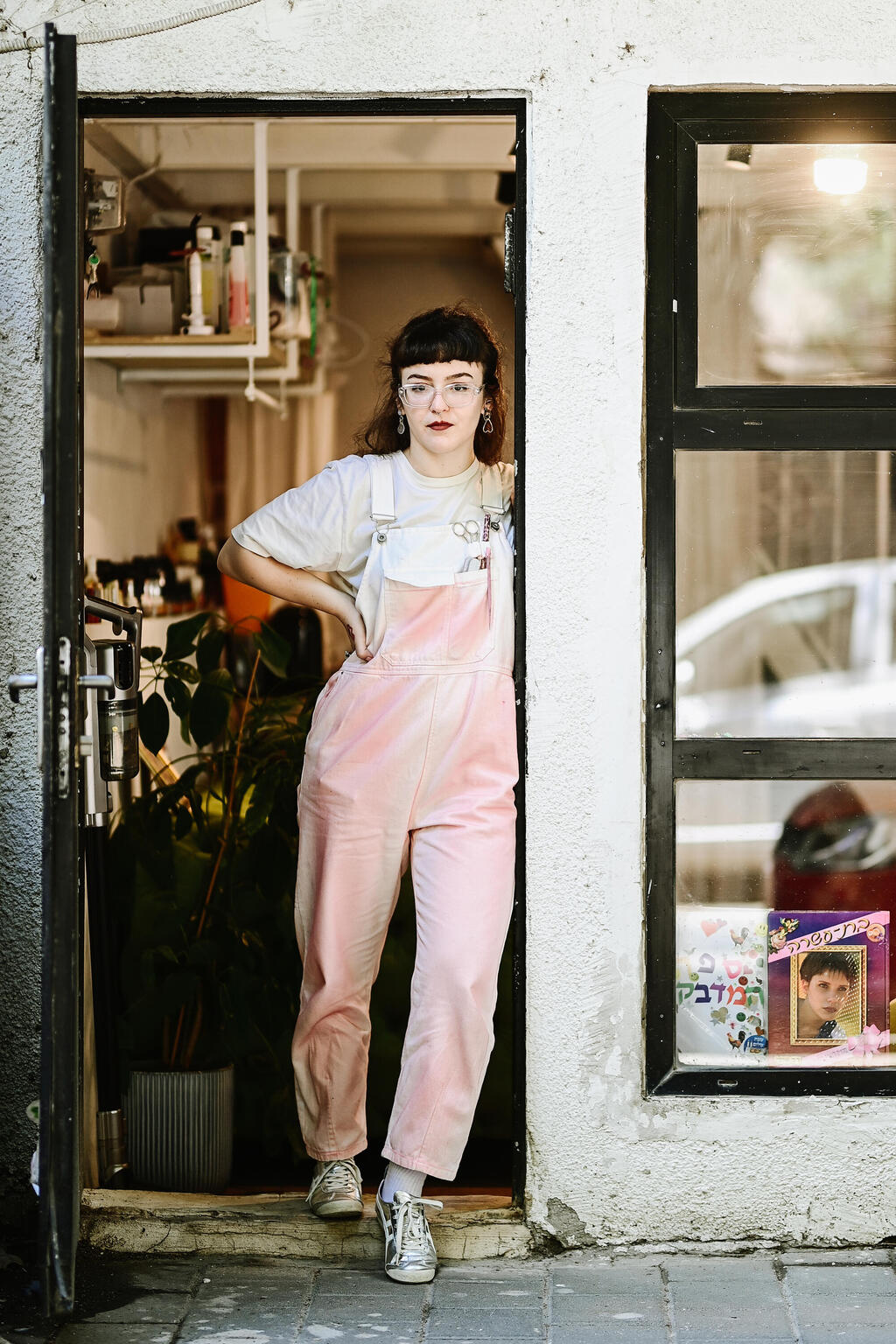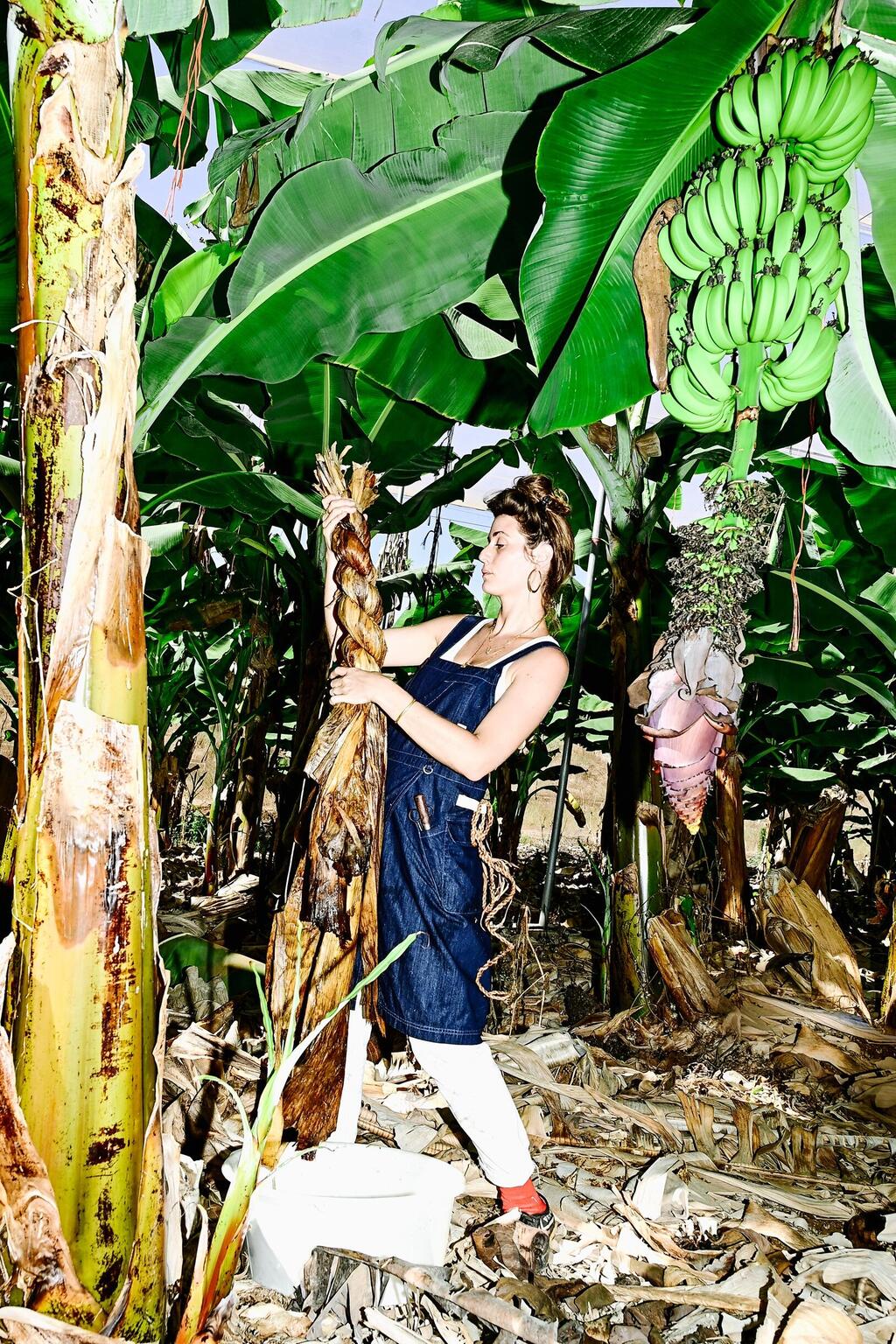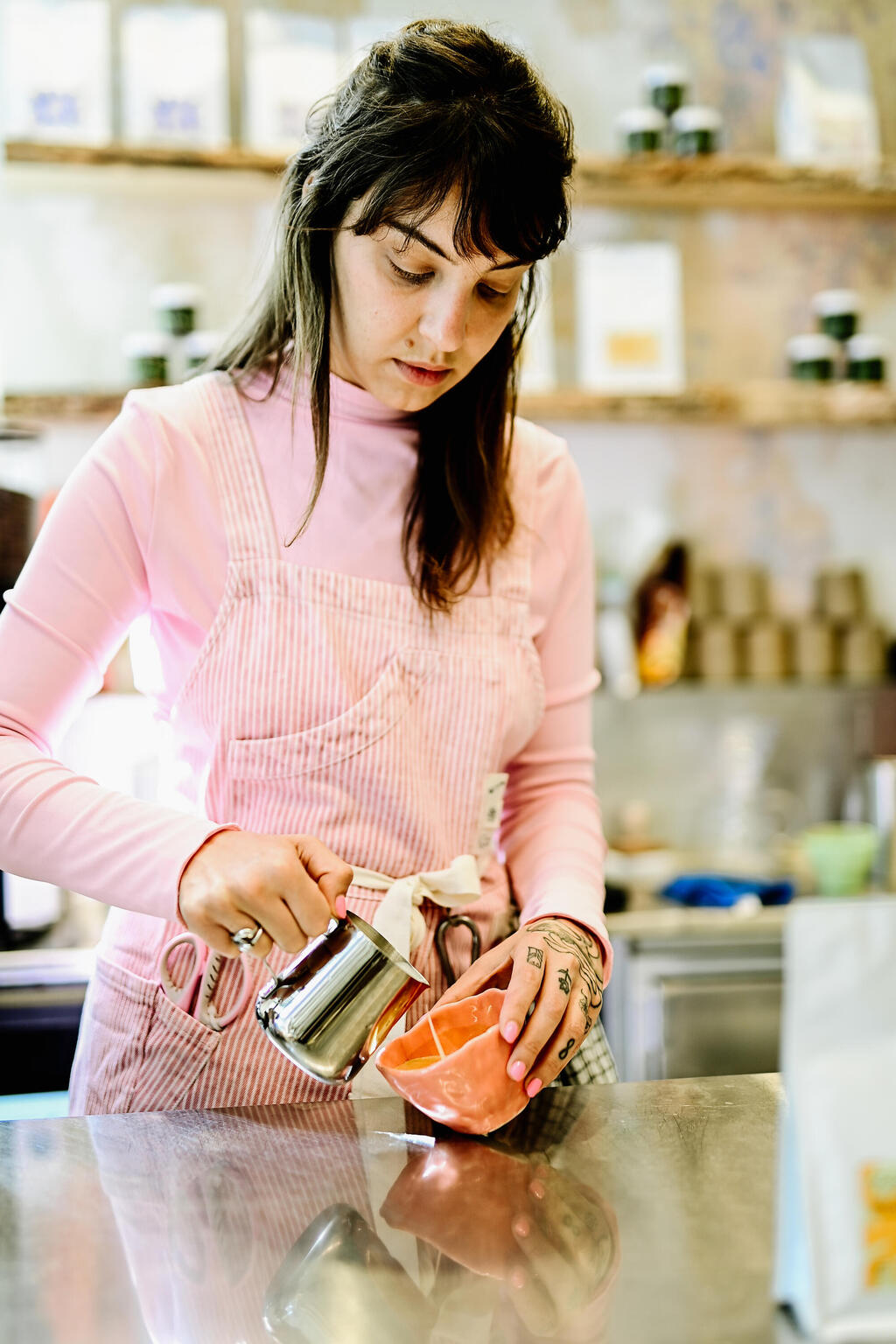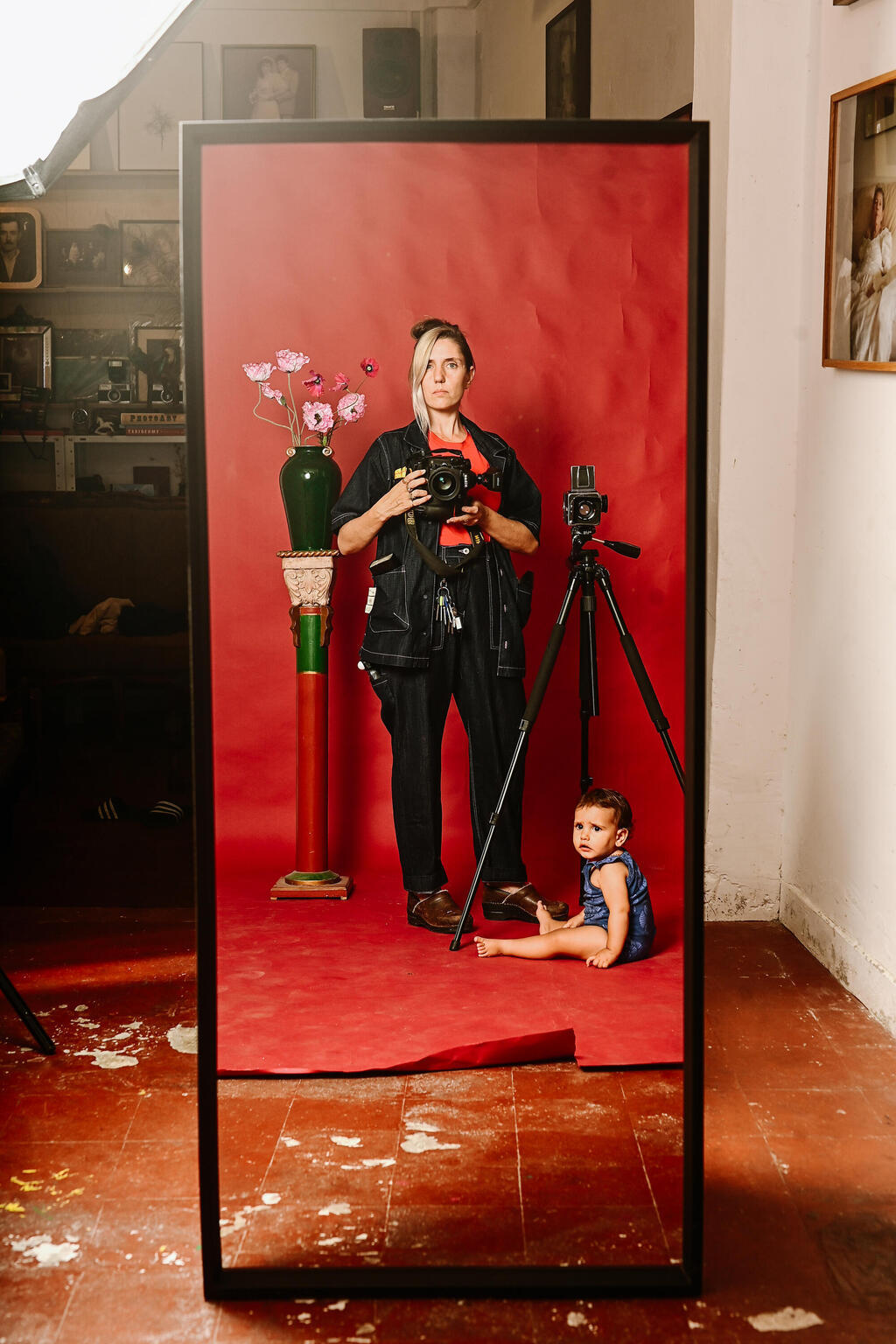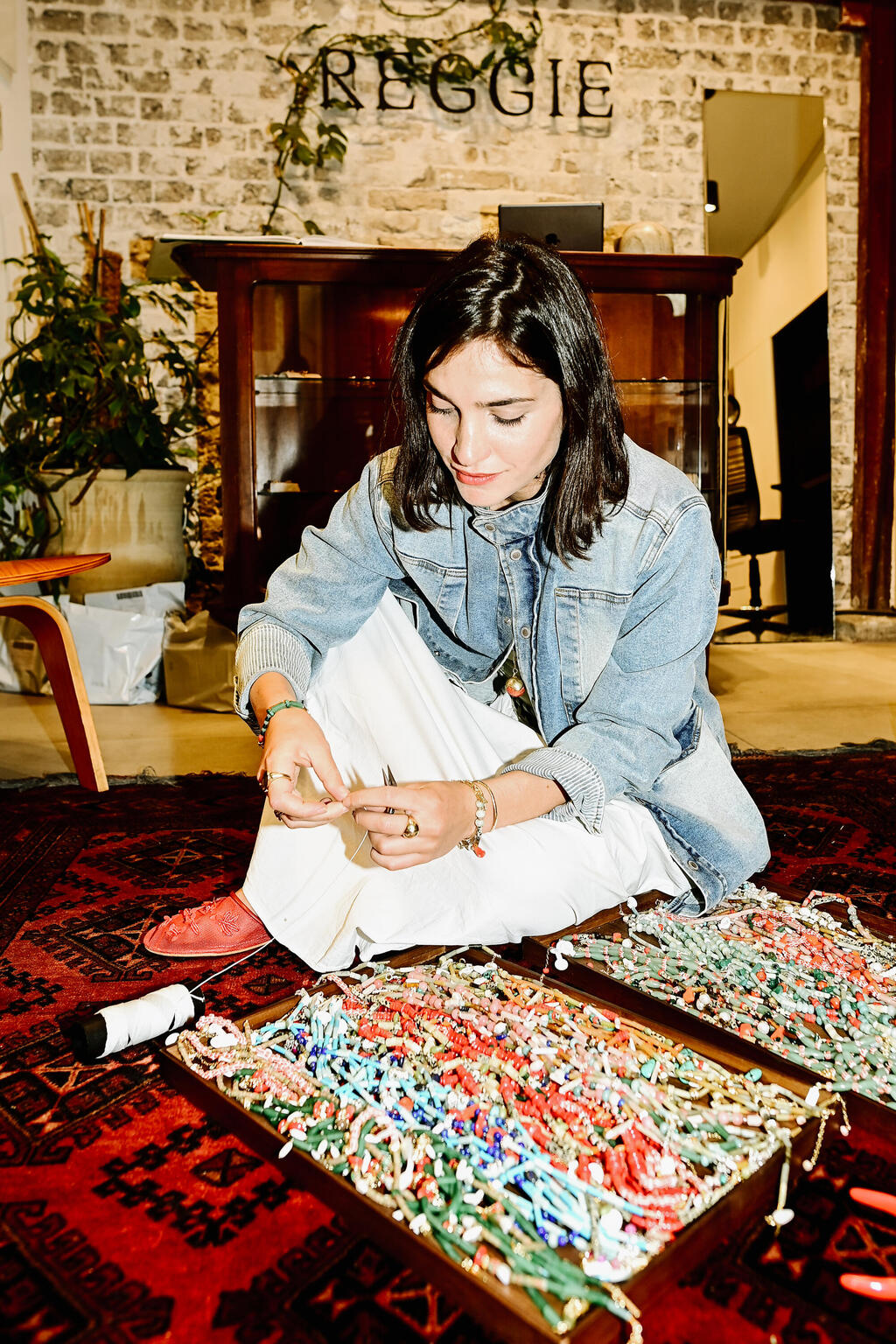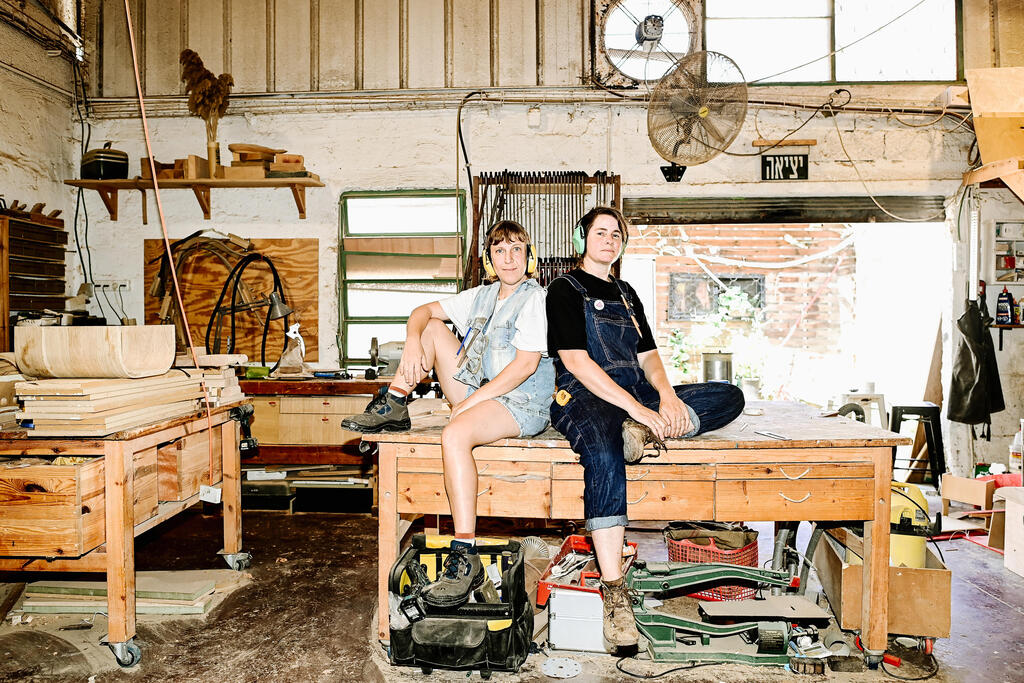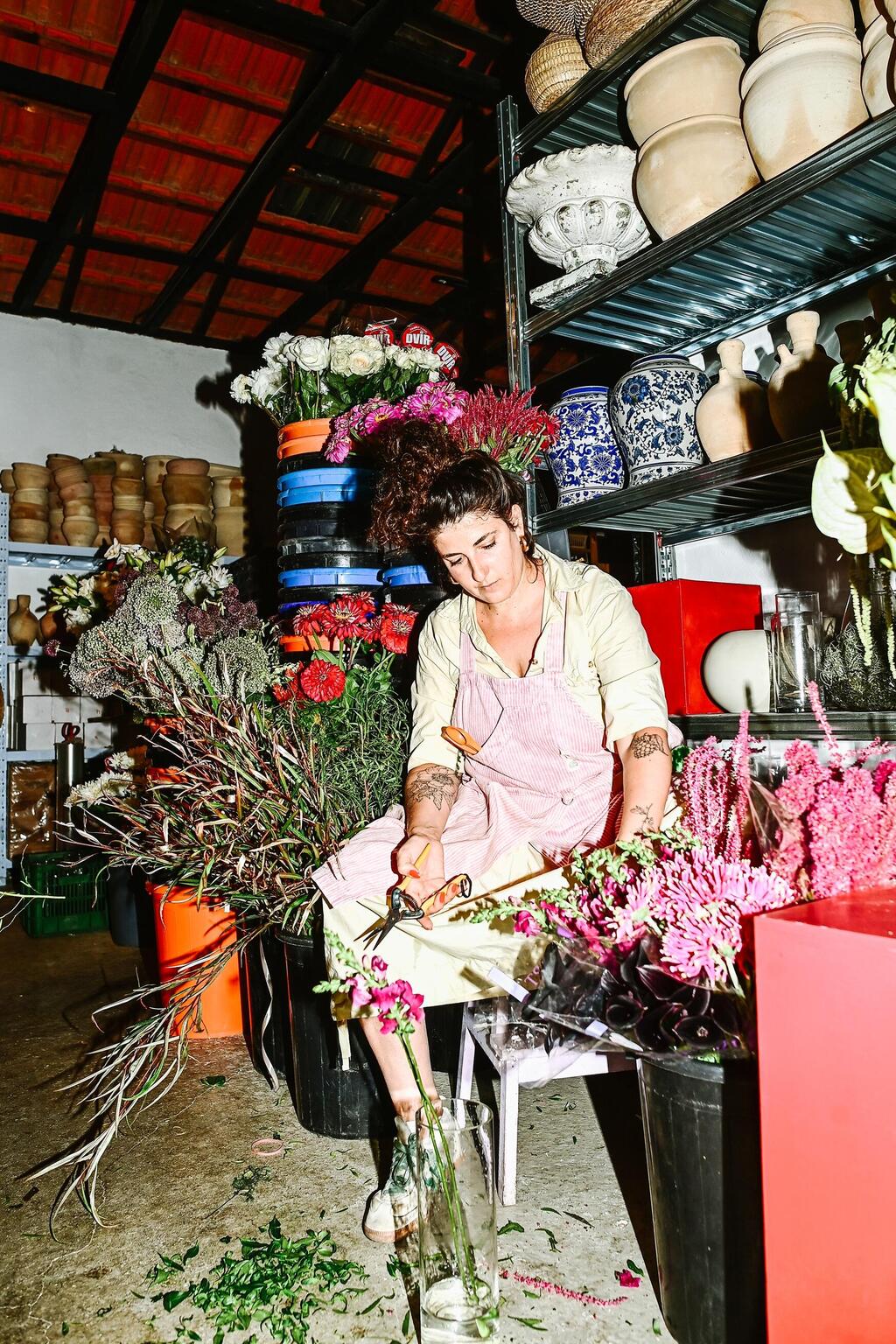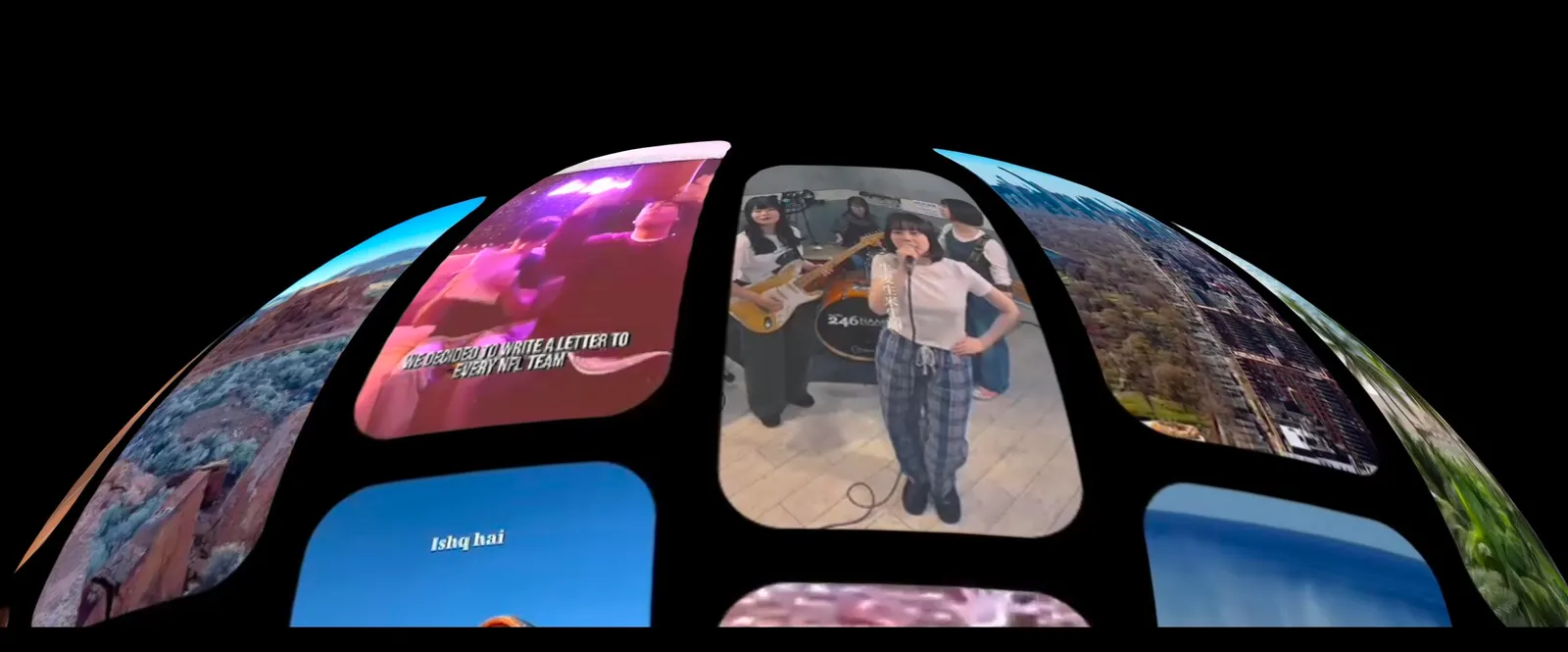In 2016, Anat Glazer and Doron Shai founded “Ba’alot Melacha” – a boutique carpentry workshop in Tel Aviv offering custom wood products or items available for direct online purchase, like the “Sharfaf” – a combination stool and flip-flop that helps you reach items on high shelves. The work clothes they found in specialized stores proved unsuitable from the start for their body structure and needs as women. “The clothes were uncomfortable, ugly, and masculine in style. I looked like a hipster,” Glazer recalls.
During the “Fresh Paint” fair in May, an original workwear project was unveiled – created by “Ba’alot Melacha” in collaboration with veteran fashion house Comme Il Faut. The one-time collection consists of denim aprons, multi-pocket vests, work jackets and more, currently sold in the brand’s stores and website. The collaboration began after Glazer approached Sybil Goldfeiner, the brand owner, following unsuccessful attempts to create work clothes on her own.
Work clothes is a collective term for garments historically developed for men by men, leaving many women without adequate solutions in the workplace. To this day, most work clothes are designed according to masculine cuts and dimensions unsuitable for the female body – from coveralls that are too loose to gloves too large that prevent safe and efficient functioning.
Beyond the fit problem, the workwear field needs feminine precision in planning and understanding the specific needs of working women – from addressing different movement patterns, through hygiene and comfort considerations, to understanding the unique challenges women face in various professions. As women constitute a significant part of the workforce across a wide range of professions, the need for products truly adapted to women – not just smaller versions of men’s products – has become more urgent than ever.
“Besides the need for pockets in the right places and sizes that fit the female body, the designs also accommodate women’s changing needs throughout the day,” adds Romi Kaminer-Goldfeiner, marketing manager of Comme Il Faut and the brand’s next generation. “A woman takes her child to kindergarten in the morning, maybe stops for yoga afterward, then arrives at her workshop, and after work needs to continue her day. The clothes are adapted to all these needs.”
The clothes essentially offer an additional layer to the clothing system and can be worn over existing garments so they don’t ruin what you came from home wearing, like a jacket or vest. All the craftswomen we spoke with and photographed for the project – from photographers to nail designers – say they’ve learned to adapt “regular” clothes as “work clothes,” like garments that have seen better days. Others no longer make the distinction between work and leisure hours.
Alongside the rough denim fabrics, some garments were created in diverse and “feminine” colors like baby pink, which Glazer admits she initially disliked. “It conveys delicacy and we’re not like that. I’m a ‘carpenter boy,’ but now I feel like a ‘carpenter woman,'” she clarifies the nuances and interpretations added to work clothes. “The clothes allowed me the feminine performance that strengthens my identity as a craftswoman.”
Since its founding in 1987, Comme Il Faut has presented a feminist agenda, often drawing backlash and criticism for its political moves, aimed primarily at elite women. This time too, their important choice to spotlight women’s work clothes – a field usually inadequately addressed by specialized clothing companies – raises a gap between work clothes associated with the working class and the brand’s clientele, who likely never worked in manual labor for their livelihood; and whether those “workers” who need work clothes will pay 1,295 shekels for jeans and 695 shekels for an apron.
“This issue came up,” Kaminer-Goldfeiner acknowledges. “I believe that just as you invest money in a good work product, like a drill – work clothes serve you throughout the day and the investment is good and long-term.”
“We sit in a similar niche,” Glazer adds. “We produce high-end quality products in fair trade, with a lot of soul and attention, and that’s not always cheap.”
Profession: Ceramicists. Age: 38 (both). Experience: “Almost a decade.”
What do you wear to work? Jersey: “Since we work in a messy profession, at first I used to bring a dedicated set of clothes to the studio that I didn’t mind getting dirty. At some point I realized that almost all day I’m wearing the dirty clothes, so it’s better if they’re clothes I actually like wearing. Since then I barely have any separation in my closet. All the clothes are work clothes and everyday clothes, and they’re all a bit dirty.” Tal: “During studies I bought a painting coverall at some supply store. I thought I’d cracked the system, but who wants to walk around looking like that all day? Since then I’ve surrendered to the fact that my clothes tell what I do, and I wear clothes I love to the studio.”
What garment do you most like wearing to work? Jersey: “Probably the apron. A bit like army uniform, you can smear everything on it and it’s fine, it’s a clothing item and towel in one product.” Tal: “Pants with pockets. Always need more pockets.”
What’s missing most for you in work clothes? Jersey: “Work clothes. Clothes made from good, strong fabrics that can be cleaned easily and still look good on the body. In the end, most people see me in my work clothes.” Tal: “Pockets and flattering cuts. With all due respect to military surplus pants, they can and should be improved into pants with cuts that also do justice to women.”
How do you manage with the fact that most work clothes are designed for men? Jersey: “Don’t buy them.” Tal: “Sometimes I buy from men’s departments because the cut or length suits me, but in work clothes I haven’t found anything that’s both comfortable and beautiful.”
How do you balance wanting to feel good about yourself with the physical demands of work? Jersey: “The physicality of the work is one of the things that makes me feel best about myself. I admit that walking around Tel Aviv with clay-stained clothes also makes me happy – part of the visibility is my craft.” Tal: “I walk around with dirty clothes with pride, in Tel Aviv everything’s allowed.”
If they developed a workwear collection for women only – what would you want in it? Jersey: “Overalls! I’ve been looking for good work overalls for years. Additionally, I’d want clothes that don’t wear out quickly, can be cleaned easily and fit well on the body, that think about my body.” Tal: “Good fabrics that won’t catch plaster and clay stains.”
Is there something about your work clothes that makes you feel pride or power?
Profession: Nail artist. Age: 26. Experience: Five years.
What do you wear to work? “Everyday clothes that have been through a thing or two, with an apron over them that partially covers me. Usually dark jeans or corduroy pants, so if they get dirty I can somehow camouflage it; and after work I can continue to coffee with friends without looking too disheveled. It doesn’t leave many options.”
What garment do you most like wearing to work? “An oversized shirt with a print and short leggings. The oversized protects me mentally, and even when I put on an apron you can still see the shirt hem and the final look has character.”
What’s missing most for you in work clothes? “Colors, pockets, hooks for tools. I’m really scattered and need as many pockets as possible, otherwise I’ll lose everything. Since the garment gets dirty with different colors anyway, so let’s make it more interesting.”
How do you manage with the fact that most work clothes are designed for men? “It’s a depressing status quo and we mustn’t get used to this fact. The more competition there is in this market segment, the more variety we’ll have to purchase from.”
How do you balance wanting to feel good about yourself with the physical demands of work? “The physical demands of the work are mainly the static nature of applying polish and working on very small objects. Fun fact – gel polish never comes out of clothes, not even with degreaser. You need to think very carefully about what you wear to work.”
If they developed a workwear collection for women only – what would you want in it? “For it to be pink.”
Is there something about your work clothes that makes you feel pride or power? “My apron was sewn by my grandmother from fabric remnants. It took time until I allowed myself to actually get it dirty, but grandma is my pride in everything related to talent, work, and craft.”
Profession: Multi-disciplinary creator, weaver, works in handicrafts. Age: 32. Experience: “All my life.”
What do you wear to work? “There’s no clear separation in my wardrobe between work clothes and everyday wear, since my day isn’t sharply divided between work time and personal life either. There are periods of projects where I need separation and periods of crystallization, thinking and planning – and there I’ll choose to wear what’s most me that day and can inspire me.”
What garment do you most like wearing to work? “Jeans are always a preferred work garment, ones that have accompanied me for years and taken the shape of my body, that I know them and they know me.”
What’s missing most for you in work clothes? “Pockets in all shapes and sizes. My thinking is associative and sometimes I jump from thing to thing. It’s convenient for me to have everything on me during work.”
How do you manage with the fact that most work clothes are designed for men? “With the help of my sewing machine. Everything that needs it goes through repair.”
How do you balance wanting to feel good about yourself with the physical demands of work? “I don’t have anything in my wardrobe that I don’t feel good in or that really restricts my movement.”
If they developed a workwear collection for women only – what would you want in it? “The Ba’alot Melacha and Comme Il Faut apron is a perfect example. It both protects me and the clothes underneath, and creates storage space on my body for my work tools. It’s flattering and beautiful, and that’s important and pleasant to me.”
Is there something about your work clothes that makes you feel pride or power? “When I’m free in my movement in space, and the materials the garment is made from are good, breathable and quality.”
Profession: Tattooist and cafe owner. Age: 38. Experience: “Can’t remember anymore.”
What do you wear to work? “I haven’t yet gotten around to designing uniforms for our cafe, but I have in mind a shirt and apron I’d want everyone at the cafe to wear, maybe even a hat or bandana. Meanwhile, I just pull from the closet early in the morning whatever comes out.”
What garment do you most like wearing to work? “I like wearing black, because it’s practical (you see fewer stains) and because I’ve always felt it’s my color.”
What’s missing most for you in work clothes? “Flattering clothes in cuts suitable for women, made from quality materials and not cheap ones.”
How do you manage with the fact that most work clothes are designed for men? “Like many other things in life, it’s very frustrating and depressing that the default is always masculine – whether it’s unpleasant fabrics and unflattering cuts, or sizes that are too big.”
How do you balance wanting to feel good about yourself with the physical demands of work? “I wake up early in the morning to have time to dress nicely, invest in hair and makeup (though I don’t always have time) and also insist on gel polish sometimes. In real life it happens that I get dirty within seconds, and then the look is ruined.”
If they developed a workwear collection for women only – what would you want in it? “Aprons with lots of pockets, because I really love pockets and want as many as possible. Additionally, matching sets of shirt and pants or skirt and bandana.”
Is there something about your work clothes that makes you feel pride or power? “Since my work clothes are my regular clothes, I can say I’m proud to be a woman, and more specifically a woman who works hard with her hands and still manages to look good and feel feminine.”
Profession: Photographer. Age: 35. Experience: “Since the camera they gave me in first grade.”
What do you wear to work? “The subject of work clothing has always been an issue for me. In recent years I found overalls in New Zealand that managed to suit almost my needs, and I loved them so much I bought five identical units. I always look like I haven’t changed clothes during wedding season, but actually I have sets of the same t-shirt and same overalls.”
What garment do you most like wearing to work? “For weddings – overalls; for studio shoots – long jeans and denim jacket (like fishermen’s but with long sleeves); and for outdoor shoots – short pants and shirt with pockets.”
What’s missing most for you in work clothes? “To feel on one hand beautiful, and on the other hand comfortably dressed and equipped according to my needs as a photographer.”
How do you manage with the fact that most work clothes are designed for men? “I feel it in every choice I’ve had so far in purchases I made of work uniforms. I manage because I have to, but there’s always something that doesn’t sit quite right for me.”
How do you balance wanting to feel good about yourself with the physical demands of work? “I always feel like it comes at the expense of something – either I won’t be comfortable but will look reasonable, or I’ll look like a construction worker in a crowd of people dressed nicely for an evening.”
If they developed a workwear collection for women only – what would you want in it? “The moment I received the jeans and button-down shirt from the Comme Il Faut project, I haven’t taken them off for any studio shoot. It’s exactly what I need during extended family photography. The uniforms stay in the studio and are only taken out for laundry. Everything’s right for me: flexible jeans with room for film rolls, there are pockets for flash and lens, room for key chain, convenient hanging hook.”
Is there something about your work clothes that makes you feel pride or power? “In every session I had wearing the new uniforms, I received compliments and felt like all the professionals who have uniforms – only for a photographer. Until now I hadn’t felt a certain power, just a need that had no answer.”
Profession: Jewelry designer. Age: 32. Experience: Nine years.
What do you wear to work? “It varies a lot, because my profession is very special. On one hand, everything is produced in the studio in traditional hand work that’s dirty and Sisyphean, and on the other hand I sell designs and diamond rings for thousands of shekels in the studio; so there’s an ‘issue’ with my clothing, because it needs to be very comfortable and able to get dirty, and also representative and full of style so I’ll feel comfortable and feel like myself.”
What garment do you most like wearing to work? “I like wearing loose – clothes from natural, pleasant fabrics!”
What’s missing most for you in work clothes? “When sitting to work at the goldsmith’s table and reaching the polishing and finishing stage, most of the dirt flies onto the clothes and knees. I have an idea for the next collection: an apron/work shirt that connects to the work table like a kind of tablecloth that links me to the table, and at the end of work I can take the apron corners with me and shake them outside. This way I won’t get dirty and the studio floor will stay clean too.”
How do you manage with the fact that most work clothes are designed for men? “I see it as an advantage, since the loose cuts allow me to choose clothes that match my comfort and need. And then I adapt the clothes to my style, improve them and utilize their advantages.”
How do you balance wanting to feel good about yourself with the physical demands of work? “Maneuvering between the smocks and work shirts, to the chic jackets. Cleaning and washing all the black from the face several times a day.”
If they developed a workwear collection for women only – what would you want in it? “Comfortable and dark items made from natural fabrics, that won’t show the dirt and at the end of the day can be cleaned easily. Additionally, work shirts with raised collar that will protect as much as possible the chest area. Maybe comfortable work glasses, something with a bit more chic.”
Is there something about your work clothes that makes you feel pride or power? “I’m very proud to wear work clothes. I feel that work clothes always make me connected to the ground, to the essence of creation, to the process and to manual work, and that’s important to me as a designer. Despite the difficulties and complex situation, I’m very proud to create something from nothing here in our country, in a Tel Aviv studio with a female team using quality materials, some recycled, under fair production conditions.”
Profession: Carpenters. Age: 38 (both). Experience: “Over a decade of joint creation, woodworking.”
What do you wear to work? “Most days we wear clothes from our closet. There’s really a clear division between work clothes and ‘after work’ clothes. Work clothes need to be comfortable, with pockets, ones you can get dirty without thinking twice.”
What garment do you most like wearing to work? “Vest! Even on hot days when we wear t-shirt and short leggings, the vest adds a comfortable and functional layer, with accessible pockets for the work tools we need. It’s worn over and always looks appropriate.”
What’s missing most for you in work clothes? “The big lack is adaptation to women. In most cases work clothes just aren’t built for the female body structure. It’s frustrating and it was exactly the trigger that made us think about this special project together with Come Il Faut.”
How do you manage with the fact that most work clothes are designed for men? “Not easily. It’s a daily challenge to find clothes that both fit physically, allow movement and comfort, and give a good feeling about ourselves.”
How do you balance wanting to feel good about yourselves with the physical demands of work? “It’s an ongoing struggle, but from this challenge our dream was born: to create feminine work clothes that don’t compromise – not on looks and not on functionality.”
If they developed a workwear collection for women only – what would you want in it? “The collection we created is exactly the answer to this question: clothes adapted to a woman’s body, comfortable, functional, with pockets in the right places, and with emphasis on beauty. Ones you can wear both in the carpentry shop and to a meeting outside.”
Is there something about your work clothes that makes you feel pride or power? “Absolutely. Our clothes remind us every morning why we do what we do. They’re part of our professional identity, of our choice to get up and create, to build and work with hands and heart.”
Profession: Florist and event designer. Age: 35. Experience: 12 years.
What do you wear to work? “Depends on my mood. I’m a very colorful person and like to be dressed in style, and that doesn’t always connect to the fact that there’s such dirty work. So usually I pull out pretty rags that were once pretty clothes. If it’s event design, I’m always dressed in a festive and pressed garment on a hanger that I change into before the couple arrives.”
What garment do you most like wearing to work? “An apron where I can put all the florist equipment. If I’m in formal wear like a button-down shirt it looks amazing, like a flower seller in Paris.”
What’s missing most for you in work clothes? “For them to have beautiful color and quality fabric. All aprons are usually in black and white shades from simple, ugly fabric. It’s not respectful to wear them.”
How do you manage with the fact that most work clothes are designed for men? “Exactly for this reason I don’t buy work clothes.”
How do you balance wanting to feel good about yourself with the physical demands of work? “A pretty apron with a button-down shirt underneath.”
If they developed a workwear collection for women only – what would you want in it? “Quality fabrics, colors, solutions and professional appearance.”
Is there something about your work clothes that makes you feel pride or power? “Yes, when it fits perfectly!”
